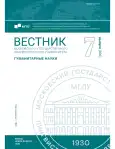Evolution of Headlines in the Digital Media Era: Semantics, Syntax, Pragmatics (based on Italian headlines)
- Autores: Gorbyleva A.V.1
-
Afiliações:
- Diplomatic Academy of the Ministry of Foreign Affairs of the Russian Federation
- Edição: Nº 7(901) (2025)
- Páginas: 25-32
- Seção: Linguistics
- URL: https://ogarev-online.ru/2542-2197/article/view/303270
- ID: 303270
Citar
Texto integral
Resumo
The paper analyzes the structure of headlines in the Italian press in the digital era. The goal is to identify trends in headline transformation and their adaptation to modern media formats. To achieve this goal, we employed methods of structural, semantic and pragmatic analysis of headlines. The research material consists of headlines of Italian media. The findings reveal structural changes in headlines, their theme-rheme organization features and the role of punctuation in their compo sition. The study develops a typology of nominal themes, identifying structural models of themes (single-component, two-component, and three-component). Key trends include increased expressiveness and communicative autonomy.
Sobre autores
Anastasia Gorbyleva
Diplomatic Academy of the Ministry of Foreign Affairs of the Russian Federation
Autor responsável pela correspondência
Email: a.gorbyleva@dipacademy.ru
PhD (Philology), Associate Professor at the Department of European Languages
RússiaBibliografia
- Boczkowski, P. J., Mitchelstein, E., Matassi, M. (2018). News comes across when I’m in a moment of leisure: Understanding the practices of incidental news consumption on social media. New Media & Society, 20(10), 3523–3539. doi: 10.1177/1461444817750396.
- Nazarenko, A. I. (2024). Manifestation of the Economy Principle in the Italian media discourse. Vestnik of Moscow State Linguistic University. Humanities, 6(887), 72–77. (In Russ.)
- Gabielkov, M., Ramachandran, A., Chaintreau, Au., Legout, A. (2016). Social clicks: what and who gets read on Twitter? ACM SIGMETRICS Performance Evaluation Review, 44(1), 179–192. doi: 10.1145/2964791.2901462.
- Newman, N. et al. (2023). Reuters Institute Digital News Report 2023. Reuters Institute for the Study of Journalism. doi: 10.60625/risj-p6es-hb13.
- Molyneux, L., Coddington, M. (2019). Aggregation, clickbait and their effect on perceptions of journalistic credibility and quality. Journalism Practice, 14(4), 429–446.
- Zhou, X., Jain, A., Phoha, V. V., Zafarani, R. (2020). Fake News Early Detection: A Theory-Driven Model. Proceedings of the AAAI Conference on Artificial Intelligence, 1(1), 1–25. doi: 10.48550/arXiv.1904.11679.
Arquivos suplementares










